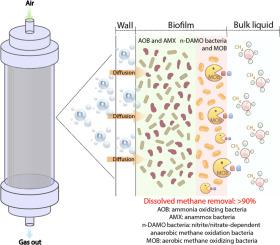Gas-delivery membrane as an alternative aeration method to remove dissolved methane from anaerobically treated wastewater
IF 11.4
1区 环境科学与生态学
Q1 ENGINEERING, ENVIRONMENTAL
引用次数: 0
Abstract
Dissolved methane is a hurdle for anaerobic wastewater treatment, which would be stripped into the atmosphere by conventional bubble aeration and increase the release of greenhouse gases into the environment. The high oxygen transfer efficiency and less turbulence in membrane aerated biofilm reactor (MABR) could prevent the stripping of dissolved methane. In this study, an MABR was established to remove dissolved methane aerobically in parallel to the nitrogen removal driven by the anammox process. The long-term results demonstrated that aerobic methane oxidation has a short start-up period, in which a high level (>90 %) of dissolved methane removal was achieved in 20 days. Meanwhile, the anammox-based nitrogen removal process reached a total nitrogen removal rate of ∼150 mg N/L/d (0.27 g N/m2/d). In situ batch tests confirmed the active bioreactions of ammonia-oxidizing bacteria, nitrite-oxidizing bacteria, anammox bacteria and aerobic methanotrophs, while 16S rRNA gene amplicon sequencing further validated their existence. Moreover, nitrite/nitrate-dependent anaerobic methane oxidation (n-DAMO) bacteria were enriched to a relative abundance of 2.5 % on Day 372, suggesting their potential role in removing nitrogen and dissolved methane in the MABR. This study provides an alternative technology for removing dissolved methane and nitrogen in parallel from anaerobically treated wastewater.


气体输送膜作为一种替代曝气方法,用于去除厌氧处理废水中的溶解甲烷
溶解甲烷是厌氧废水处理的一个障碍,传统的气泡曝气会将其剥离到大气中,增加温室气体的排放。膜充气生物膜反应器(MABR)的氧气传输效率高、湍流小,可以防止溶解甲烷的剥离。在这项研究中,建立了一个 MABR,在厌氧过程脱氮的同时,以好氧方式去除溶解的甲烷。长期结果表明,好氧甲烷氧化的启动期很短,在 20 天内就能达到很高的溶解甲烷去除率(90%)。同时,基于 anammox 的脱氮工艺的总脱氮率达到了 150 mg N/L/d(0.27 g N/m2/d)。原位批量试验证实了氨氧化细菌、亚硝酸盐氧化细菌、anammox 细菌和好氧甲烷营养体的活跃生物反应,16S rRNA 基因扩增片段测序进一步验证了它们的存在。此外,在第 372 天,亚硝酸盐/硝酸盐依赖性厌氧甲烷氧化细菌(n-DAMO)的相对丰度富集到 2.5%,表明它们在 MABR 中清除氮和溶解甲烷的潜在作用。这项研究为同时去除厌氧处理废水中的溶解甲烷和氮提供了一种替代技术。
本文章由计算机程序翻译,如有差异,请以英文原文为准。
求助全文
约1分钟内获得全文
求助全文
来源期刊

Water Research
环境科学-工程:环境
CiteScore
20.80
自引率
9.40%
发文量
1307
审稿时长
38 days
期刊介绍:
Water Research, along with its open access companion journal Water Research X, serves as a platform for publishing original research papers covering various aspects of the science and technology related to the anthropogenic water cycle, water quality, and its management worldwide. The audience targeted by the journal comprises biologists, chemical engineers, chemists, civil engineers, environmental engineers, limnologists, and microbiologists. The scope of the journal include:
•Treatment processes for water and wastewaters (municipal, agricultural, industrial, and on-site treatment), including resource recovery and residuals management;
•Urban hydrology including sewer systems, stormwater management, and green infrastructure;
•Drinking water treatment and distribution;
•Potable and non-potable water reuse;
•Sanitation, public health, and risk assessment;
•Anaerobic digestion, solid and hazardous waste management, including source characterization and the effects and control of leachates and gaseous emissions;
•Contaminants (chemical, microbial, anthropogenic particles such as nanoparticles or microplastics) and related water quality sensing, monitoring, fate, and assessment;
•Anthropogenic impacts on inland, tidal, coastal and urban waters, focusing on surface and ground waters, and point and non-point sources of pollution;
•Environmental restoration, linked to surface water, groundwater and groundwater remediation;
•Analysis of the interfaces between sediments and water, and between water and atmosphere, focusing specifically on anthropogenic impacts;
•Mathematical modelling, systems analysis, machine learning, and beneficial use of big data related to the anthropogenic water cycle;
•Socio-economic, policy, and regulations studies.
 求助内容:
求助内容: 应助结果提醒方式:
应助结果提醒方式:


